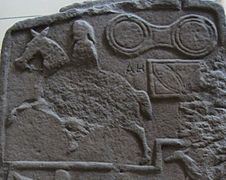Woodwrae Stone
The Woodwrae Stone (also Woodwray Stone) is a Class II (8th or 9th century) Pictish symbol stone that was found in 1819 when the foundations of the old castle in Woodwrae, Angus , Scotland were cleared. It had been used as a floor plate in the castle kitchen. It came into the collection of Sir Walter Scott (1771-1832) in Abbotsford House and has been in the Museum of Scotland in Edinburgh since 1924 .
The stone is a cross-slab with a height of 1.75 meters and a width of 1.02 meters, which tapers towards the top to 0.84 meters and is 12.5 centimeters thick. The plate is carved in relief on both sides and, as it is provided with Pictish symbols, falls into stone class II according to the classification system of John Romilly Allen and Joseph Anderson.
The front used to have a cross that was deliberately erased, whereby the edges decorated with wickerwork and knots are retained. The fantastic creatures in the four quadrants surrounding the cross also remained intact, including an animal with human legs in its mouth, a feature found on other Pictorial cross plates, including the Dunfallandy Stone , as well as on Irish high crosses .
The back, which is divided into three sections with Pictish symbols, has suffered considerable deformations. The upper part shows a tab, a double disc and another disturbed symbol. The lower two thirds show a second rider and other animals, including a bull.
The proximity of Woodwrae Castle and the affinity with the slabs in Aberlemno has long been known and it is believed that this is where the stone originated. The historian Ross Trench-Jellicoe postulated an "Aberlemno School of Pictish Sculpture" from Iona due to the similarity in design and execution . The stones in his Aberlemno school include Aberlemno 2 (the Kirkyard Stone), Aberlemno 3, Kirriemuir 1, Menmuir 1, and Monifieth 2. On this list, Lloyd Laing has the stones from Eassie , Rossie Priory, and the Glamis 1 and Glamis 2 stones added.
- Woodwraestein
See also
literature
- Anna and Graham Ritchie: Scotland. Oxford Archaeological Guides, Oxford Paperbacks, 1998 ISBN 0-192-88002-0




